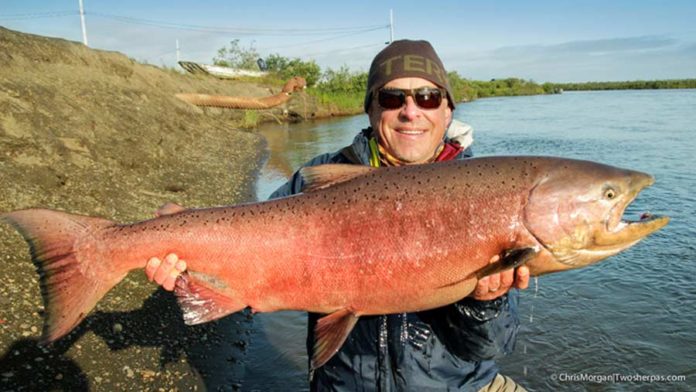Photo by Chris Morgan, www.twosherpas.com
Every June and July, anglers flock to Alaska for a chance to test their mettle—and their tackle—against king salmon, which regularly top 50 pounds and are muscular brutes after living at sea for up to eight years. The largest member of the family Oncorhynchus, which includes all Pacific salmons and trout, the king salmon makes the first big spawning run of the year in the Last Frontier, where specimens can grow to monstrous proportions, especially on the Lower Kenai River. Populations introduced in the Great Lakes don’t achieve the same size, but a king salmon hooked on Michigan’s Manistee River will bend a fly rod double just as well as its Pacific counterparts.
Range and Life History
The native range of the Chinook stretches from California’s Ventura River north to Kotzebue Sound on the western coast of Alaska, and from northern Japan to Siberia. In the western Pacific, the largest populations are on the Kamchatka Peninsula. Chinooks were planted in Lake Michigan and Lake Huron in 1967, as a way to help control populations of alewives, which were deemed too numerous for the health of the lakes. After the salmon began spawning successfully in tributaries, they were introduced to the other Great Lakes. The species had been introduced to New Zealand much earlier, starting in the late 1800s, but it took many decades to take hold. There are now sizable pelagic populations of what they call Quinnat salmon, mainly in the Canterbury region.
Chinooks spawn in larger rivers and in deeper water than other Pacific salmon, and young stay in fresh water for up to two years before migrating to estuaries, where they may spend about six months. They then head for the open ocean, where they spend between one and eight years, although three or four years are more common. Salmon who return to their natal stream early, after perhaps just one year, are smaller and called “jacks.” The timing of all these events can vary widely from watershed to watershed.
Biologists have identified a distinct “race” of Chinooks, called “ocean-type,” which are commonly found in smaller coastal streams, mostly south of the Columbia River. These fish spend less time in fresh water, perhaps having evolved as a response to the limited carrying capacity of smaller streams, and then spend their adult lives in coastal waters, rather than in the open ocean.
“Chinook” is the name of a Native American tribe of the Lower Columbia. The word tshawytscha was the common name used by natives in Alaska and Siberia.
The Search for the Century Fish
Ever since angler Les Anderson landed a 97-pound, 4-ounce king salmon on Alaska’s Kenai River in May 1985, trophy hunters have been searching for that first hook-and-line-caught king over 100 pounds. Commercial fishermen have netted fish well over the century mark on several occasions. But Alaska isn’t the only place for big fish: the California record is 88 pounds, and Oregon has produced an 83-pounder. The largest Great Lakes fish to date is a 47-pound, 13-ounce salmon caught in 1991. The biggest king ever taken on a fly was a 70-pound, 8-ounce fish caught by Grant Martinson (using a 7-pound tippet!) on Oregon’s Rogue River in 2002.
Techniques and Flies
Casting for king salmon with two-handed rods has become increasingly popular throughout the West Coast and the Great Lakes. The longer rod makes it easier to cast heavy sinking tips and larger flies, and it offers a more powerful lever to use against a running fish. In some waters, Chinooks will even strike swung flies, like a steelhead or an Atlantic salmon.

Orvis Portland Fishing Manager Brian Marz with an Oregon Chinook that fell for a size 6 Clouser Minnow.
Photo courtesy Brian Marz
Flies for king salmon come in two varieties: big, gaudy streamers to be swung, stripped, or dead-drifted; and large egg patterns to be fished like nymphs, right on the river bottom. From classics, such as the Egg-Sucking Leech, to newer creations the Popsicle and the Intruder, streamer patterns make use of materials that pulse and sway in the water, offering lots of fish-attracting action.
Conservation
As with all Pacific salmon, Chinook numbers have declined greatly from historic levels. According to a Seattle Times article, the species has disappeared from 40 percent of its range outside Alaska, and in many rivers where they do still spawn, they do so in greatly reduced numbers. Threats such as dams, logging, gold mining, pollution and overfishing have combined to bring us to the present state. Some 17 king salmon ESU’s (Environmentally Significant Units) on the West Coast are listed under the Endangered Species Act, and anglers continue to fight to help restore runs. Even Alaska isn’t immune: Northern Cook Inlet king salmon runs have been below average since 2007, and this year has seen regulation changes in the Susitna Valley in an attempt to meet escapement goals.
Credit: Source link































